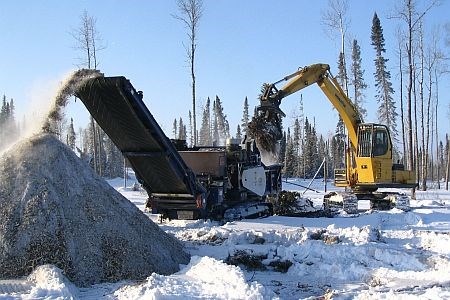Harvesting Crown biomass from Ontario forests remains a speculative market.
With no price regime in place, few people know what volumes are available for use and how far this material can be trucked before it becomes too costly for operators.
Tembec is one company that’s working to research and refine those numbers.
The Quebec-based company has always been open-minded in looking for secondary business from roadside slash, forest floor leftover and and underutilized species to ensure there’s a "true economy of scale for the forest," said Jason Linkewich, Tembec’s vice-president of procurement.
"The Ministry of Natural Resources has a lot of volume, it’s just that there’s not a lot of people that understand what it really costs to take it out of the forest."
Biomass and forest slash is the one product that hasn’t been put to its full potential, he said. So Tembec is developing some best practices of its own through ongoing field trials to figure out if the economics supports a new regime of products.
Linkewich said it’s all about "value optimization," to get the highest value from the tree to the end user.
The pulp, paper and lumber giant has been studying the issue since 2006 when they began field trials in the boreal forest to supply their co-generation boiler at their Kapuskasing mill.
The work is basically to understand what volume there is and the cost structure associated in harvesting biomass to either grind it on-site or move it quickly to the mill.
Linkewich said there is huge volume potential, but the challenge in the boreal is to figure how and when to gather material during a short five-month harvesting window, since the forest blocks can’t be accessed during summer.
There were challenges in how to sort forest slash, pile it and get maximum operating hours out of equipment, even working at night.
They’ve studied the pros and cons of loading trucks directly and grinding it on site. Linkewich said there are efficiencies and risks for both.
Ice and snow, which accumulates on piles of biomass, carry excess moisture to the mills. If that material is to be burned in a co-gen plant it may need to be dried first to obtain maximum efficiency.
Their boreal trial results show it costs $30 to $40-per green metre tonne when harvesting biomass within a 100-kilometre radius of the Kapuskasing mill.
Research has shifted to the Nipissing Forest, near North Bay, with plans to supply their Temiscaming, Que. co-generation boiler.
What they discovered so far is that their costs should come in at $25 to 30-per green tonne for a less than 50-kilometre haul.
Finding a way to work within the Crown forest rules is also being studied.
Tembec has received some exemptions from the Ministry of Natural Resources for their forest trials, but some rules, like selective harvesting, can limit opportunities.
Linkewich doesn’t necessarily see biomass becoming a stand-alone division for Tembec, but it can be a bigger portion of their business.
On the political front, he said there has to be focus on the "regionalization" of the whole use of biomass to develop pockets of Northern Ontario.
"If a local community has a pellet plant, you’ve got a marketplace that is self-contained. You don’t worry about someone else bringing in your fuel needs to make electricity, heat or pellet for homes."
It would create self-reliant communities and consistent employment, he said. "That’s the model I would like to see take off."
Unlike some conservation groups, he has no qualms about using merchantable wood for power generation. "There’s whole groups of people worried about trees going to energy, but if it’s sustainable, what’s the issue?"
www.tembec.com




